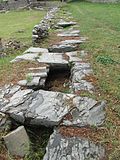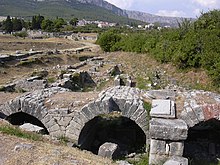Diocletian's Aqueduct
The Diocletian Aqueduct is an ancient aqueduct near Spalato / Split in Croatia , which was built during the Roman Empire around the year 300 to supply the Diocletian's Palace with water.
history
The Diocletian Aqueduct is the best preserved archaeological monument of its kind in Dalmatia. It was built around 300 AD at the same time as Diocletian's Palace. The aqueduct brought water from the karst spring of the Jadro (about 7 km northeast of today's Split) to Diocletian's Palace in Spalato and was 9 kilometers long (about 7.1 km above ground, 1.7 km in tunnels and 0.6 km across Bridges) at a height difference of 33 meters, which corresponds to an average gradient of 3.7 ‰. The cross-section of the canal varies, but averages 0.60 m × 1.50 m. The capacity in late antiquity was around 715 l / s (61,000 m³ / day).
The aqueduct bridge "Mostine" in the district of Bilice is best preserved, it has a maximum height of 15 m and a length of 234 m with a span of 2.4 m. An old view by Robert Adam (1728–1792) shows this section in 1764. Other bridges are: “Karabaš” (156 m), “Bilice” (69 m) and “Smokovik” (114 m). A tunnel section of the aqueduct is located in the basement of the Hotel Atrium (access from Put Brodarice street behind the hotel).
The Diocletian aqueduct was destroyed during the invasion of the Avars and Slavs in the 6th century and was then unusable for thirteen centuries. The first reconstruction of the aqueduct took place in 1877–1880 under Mayor Antonio Bajamonti (1822–1891) during the Austro-Hungarian rule. The aqueduct was no longer maintained from 1932 when the modern waterworks in Kopilica was completed. The aqueduct is currently being restored.
Salona
Another aqueduct that transported water from the Jadro spring to the ancient city of Salona was the "Aqueduct of Salona", built at the time of Emperor Augustus at the beginning of the 1st century. It was about 3.8 km long with a height difference of 5 m, which corresponds to a 1.3 ‰ gradient, and reached Salona at the "Porta Cesarea", where a water reservoir was built into the city gate. The sewer cross-section was around 0.80 × 1.0 m, the capacity was 12,000 m³ / day (140 l / s).
The so-called "Five Bridges" ( Croat . Pet mostova , Italian. Cinque Ponti ) in today's excavation area of Salona are not an aqueduct, but the remains of an old bridge over an arm of the river Salon (Jadro).
See also
literature
- Joško Belamarić: Dioklecijanov akvedukt. Ministarstvo kulture Republike Hrvatske, Split 1999, ISBN 953-6158-07-8 .
Web links
Individual evidence
- ↑ Split Aqueduct (accessed March 24, 2017). Roman aqueduct of Spalato (accessed March 24, 2017).
- ↑ K. Marasović et al: Water supply system of Diocletian's palace in Split - Croatia. In: IWA Regional Symposium on Water, Wastewater and Environment: Traditions and Culture. Patras, Greece, 22–24 March 2014. Hellenic Open University Press, Patras 2014, pp. 163–173 (English; PDF; 1.9 MB ).
- ^ Robert Adam: Ruins of the palace of the Emperor Diocletian at Spalatro in Dalmatia (1764). Plate LXI: View of the aqueduct which conveyed water from Salona to the palace. Franz Malota, Vienna 1910 ( online ).
- ↑ Dioklecijanov akvedukt ( Memento from December 21, 2008 in the Internet Archive ) (Croatian; accessed March 24, 2017). Diocletian's Aqueduct in Split (accessed March 24, 2017). ROMAQ project (accessed March 24, 2017).
- ^ Salona (Croatia) (English; accessed March 24, 2017).
- ↑ Five Bridges (accessed March 24, 2017).
Coordinates: 43 ° 31 ′ 26.9 ″ N , 16 ° 29 ′ 22.5 ″ E



